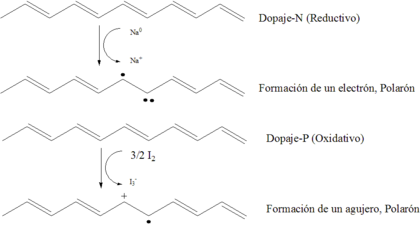
lead metals, the theory bands because there is no separation between the valence band and conduction bands, whereas in the insulating these bands are separated and need to have an excess of energy to drive. Natural polymers are insulators, due to the interaction of alternating single and double bonds create a space between the bands "Homo" and "Lumo", ie between the valence band and conduction. Through
doping is achieved the creation of carriers 'free' acting either in oxidation or reduction. Radicals are formed cations or anions.
The task of the doping agent is added or removed electrons in the polymer chain through a redox reaction.
As in traditional semiconductors, we can talk about doping n and p, where P is an oxidative doping and n is a reductive.
With doping fail to make permissible energy levels intermediate between bands, where the radicals, cations or anions allow the flow of electrons.
If the radical is neutral, then called neutral soliton, however are also possible without a radical localized loads, these are called soliton positive (cation) and negative soliton (anion).
electrical conductivity in polymers is related by the following equation: where:
n: Density charge carriers (holes / electrons)
e: Cargo carriers
μ: Mobility of charge carriers
features of freight transportation are affected by the effects of disorder, so a greater driving produces less entropy, however produce a completely ordered polymer is impossible, at least in the short term due to relaxation processes. For example, poly (3-alkyl thiophene) increases the conductivity of 10-5 to 10-2 cm2/Vs when the molecules are arranged.
While conventional metals and semiconductors decrement its conductivity with increasing temperature, the polymer conductivity increase with increasing temperature. This is achieved because the energy required to achieve the delocalization of the charges and is very easy for them interchangeably between segments of the chain.
Examples of polymers that are used as semiconductors:
Maria Linares 19881179
secc1 EES
0 comments:
Post a Comment